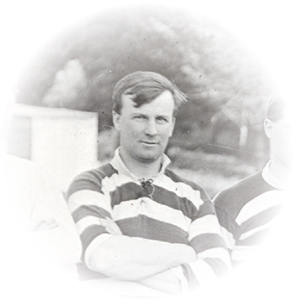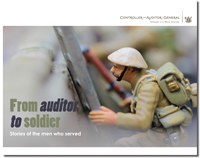John McCausland Hamilton
 John McCausland Hamilton was from Bluff and he joined the Audit Department in November 1900. At the outbreak of WW1 he had attained the position of Audit Examiner, Class V.
John McCausland Hamilton was from Bluff and he joined the Audit Department in November 1900. At the outbreak of WW1 he had attained the position of Audit Examiner, Class V.
John joined the New Zealand Expeditionary Force in June 1916, aged 32. He was sent first to the United Kingdom in October 1916 with the New Zealand Rifle Brigade. He was promoted to the rank of Lance Corporal in December 1916 and sent to France in February 1917 with the 1st Battalion, Otago Infantry Regiment.
John was badly wounded on 7 June 1917 at the Battle of Messines. Messines Ridge is an area of higher ground in Belgium that overlooked British and ANZAC positions. The Ridge had been occupied by German forces, who had developed extensive fortifications.
The capture of the Ridge and the village of Messines was seen as essential in order to allow Allied forces to advance further north. The New Zealand Division was to be part of the attack on the Ridge and the village. The attack was scheduled for 7 June 1917.
Before the attack, Allied forces had dug 21 tunnels underneath German lines and filled these with more than 455 tons of explosive. Shortly after 3am on 7 June, the mines underneath the German lines were detonated, killing thousands of German defenders. The shock wave from the explosions was said to have been felt 20 miles away. Allied forces then attacked the defending forces and the Ridge was taken in the afternoon.
In the course of this fighting, John suffered a gunshot wound to the left leg. Initially, he was treated at a field hospital on 8 June 1917, before being transferred to the New Zealand First General Hospital Brockenhurst in the United Kingdom. The medical report about his injury described it as a deep wound, down to the bone, which was fractured. The medical report recommended that he be discharged from the New Zealand Expeditionary Force because he was “permanently unfit”.
John remained in hospital until September 1917, before returning to New Zealand in November 1917. He received further medical treatment at Invercargill Hospital.
John was again medically assessed in January 1918. The assessment concluded that he would continue to suffer from lameness to his left leg and that, in terms of future civil employment, he would be suitable for light work only.
He was discharged from the New Zealand Expeditionary Force in January 1918. He was awarded the British War Medal and the Victory Medal.
John returned to work for the Audit Department and by 1921 had attained the position of Audit Inspector, Class III, Auckland.
At the outbreak of WW2, John was working for the Audit Department as an Audit Inspector. He was scheduled to retire in 1940, but he stayed on because of the need for experienced audit staff during WW2.
In July 1940, John applied to join the 2nd New Zealand Expeditionary Force. He was medically assessed and classified as fit for Home Defence and was placed in the National Military Reserve, liable to be called up in the event of an emergency.
John retired from the Audit Department in 1946 and died on 20 May 1970.

